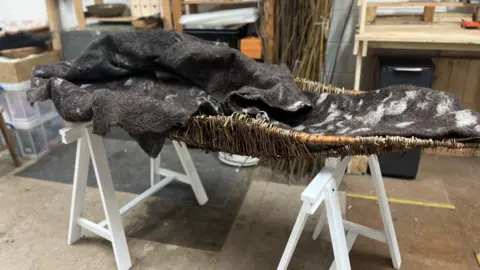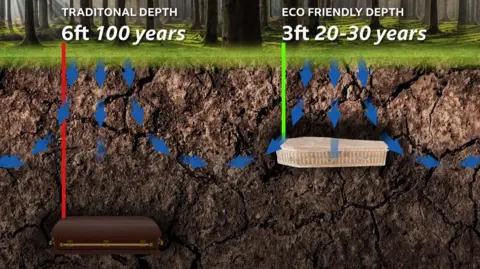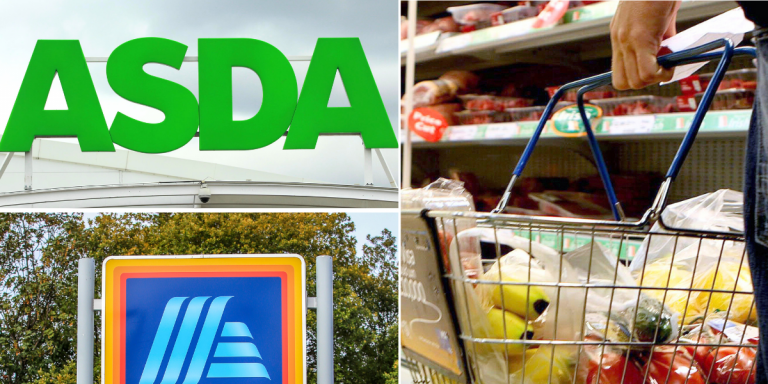 Lizzy Steel / BBC
Lizzy Steel / BBC“I don’t want my last act on this planet to be a polluting act, if I can help that,” Rachel Hawthorn explains.
She is getting ready to make her own burial shroud because she is concerned about the environmental impact of traditional burials and cremations.
“I try so hard in my life to recycle and to use less, and to live in an environmentally friendly way, so I want my death to be that as well,” she adds.
A gas cremation produces the estimated equivalent carbon dioxide emissions of a return flight from London to Paris and around 80% of those who die in the UK are cremated each year, according to a report from carbon consultancy firm, Planet Mark.
But traditional burials can pollute too. Non-biodegradable coffins are often made with harmful chemicals and bodies are embalmed using formaldehyde: a toxic substance which can leach into soil.
 Lizzy Steel / BBC
Lizzy Steel / BBCIn a recent survey from Co-op Funeralcare, conducted by YouGov, one person in 10 said they would want a more ‘eco-friendly’ funeral.
Rachel, from Hebden Bridge, West Yorkshire, made a burial shroud for a friend from locally-sourced wool, willow, bramble and ivy, as part of her work as an artist.
For years she has explored the themes of death, dying, grief and nature through crafts and functional objects.
But the 50-year-old sees the shroud, which can also remove the need for a coffin, as more than just artwork – and has since decided to make her own.
A common reaction from those who have seen the creation is to ask if they can touch it, to feel how soft it is.
For Rachel, it is the perfect way of helping people address the taboo topic of death.
She also works as a death doula, which involves supporting people who are dying, as well as their loved ones, to make informed funeral care choices.
“I find that when we talk about death, everybody I’ve met finds it a helpful and healthy thing, and something that is life-enriching,” she says.
“When somebody dies it is often so shocking. We just get on a treadmill of ‘this is what happens’, so I want to open up those conversations.
“I want more people to know there are options and that we don’t have to end up in a box.”
The practice of digging graves to a depth of 6ft (1.82m) dates back at least to the 16th Century and is believed to have been a precaution against plague.
When Rachel’s time comes, she wants a natural burial, which means using a biodegradable coffin or shroud in a shallower grave. The upper layers of soil contain more active microbes, so bodies can decompose in about 20 to 30 years, rather than up to 100 in a traditional grave.

Natural burial grounds are dotted across the UK and bear little resemblance to normal cemeteries – trees and wildflowers replace man-made grave markings, and no pesticides are used.
Embalming, headstones, ornaments, and plastic flowers are not allowed.

Louise McManus’ mother was buried last year at Tarn Moor Memorial Woodland, a natural site near Skipton. The funeral included an electric hearse, locally made wool coffin and flowers from her garden.
“She loved nature and being outside. She was concerned about what is happening to the environment and asked for her funeral to be as sustainable as possible,” Louise says.

Sarah Jones, the Leeds-based funeral director who organised the send-off, says demand for sustainability is growing.
Her business has expanded to four premises since opening in 2016 with a rise in sustainable funerals helping to drive that expansion.
She said from a “handful” of eco burials, such requests now make up about 20% of her business.
“More and more people are asking about it and want to make choices that are better for the planet. They often feel it reflects the life of the person who has died because it was important to them,” she says.
 Lizzy Steel / BBC
Lizzy Steel / BBCAs with many eco-friendly industries, natural burials can cost more. Many grounds, including Tarn Moor, offer cheaper plots to locals. One in Speeton, North Yorkshire, is community-run and puts profits back into the village playground.
At Tarn Moor, a plot plus maintenance for Skipton residents costs £1,177. Non-locals are charged £1,818. The nearest council cemetery charges £1,200 for a grave while cremation costs here start at £896.

Often away from urban areas and transport links, travelling to natural grounds for funerals, or to visit a grave, can involve a higher carbon footprint than more traditional sites, Planet Mark’s report points out.
Shroud-maker Rachel recognises these challenges but hopes for long-term change. She wants to see more local natural grounds and to normalise eco-friendly deathcare, while being respectful of others’ choices.
“In times gone by, women would arrive in their marital home with their shrouds as part of their dowry and they would be kept in the bottom drawer until they were needed,” she says.
“I don’t see why people can’t have their burial shroud just ready and waiting for them.
“I think it could be that normal, but everybody does need to have their own choices around it. It doesn’t have to be a certain way.”


























+ There are no comments
Add yours